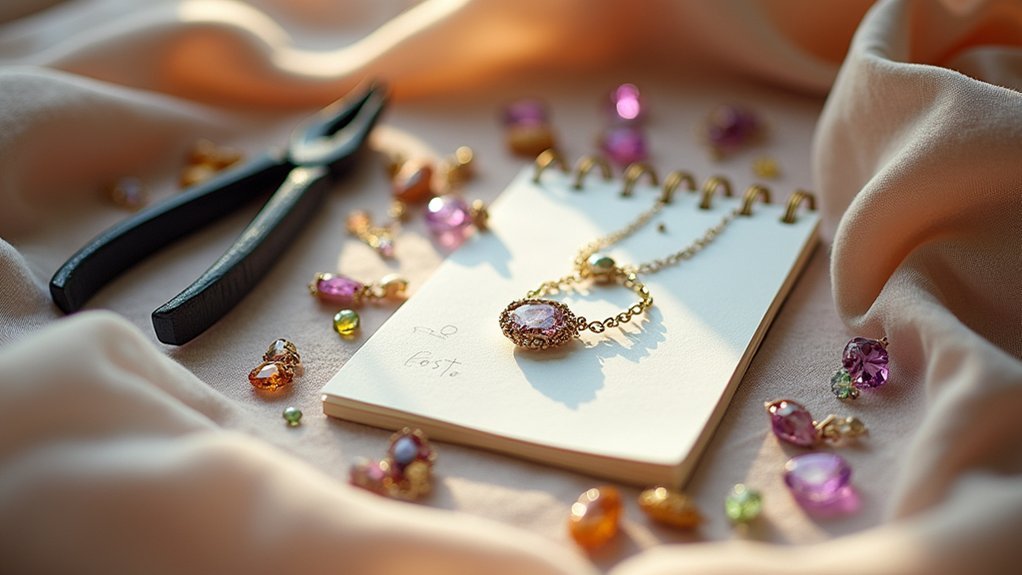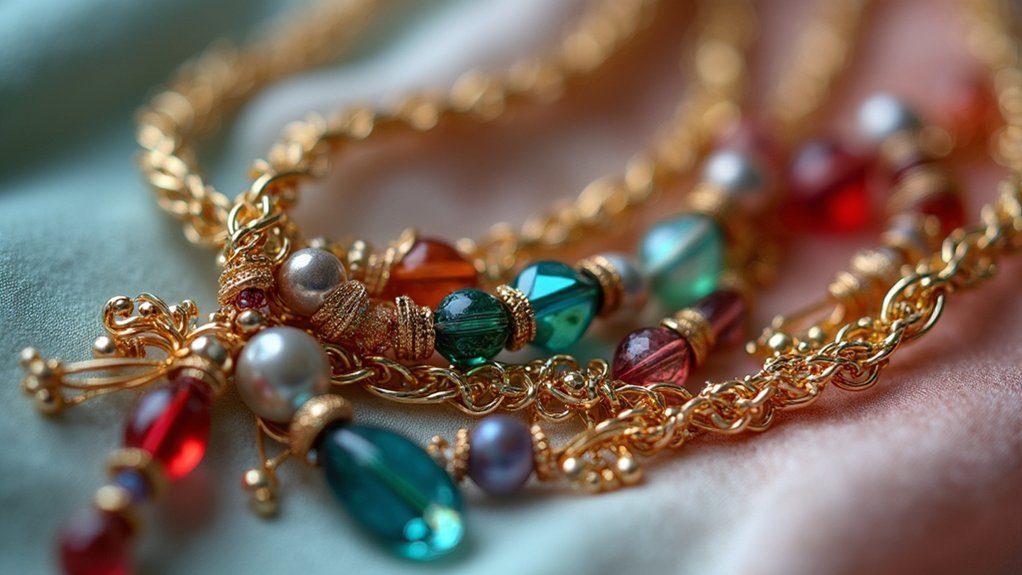You’ve probably noticed how gemstone markets evolve rapidly, making reliable grading tools essential for both professionals and collectors. In 2025, experts have identified five instruments that consistently deliver accurate assessments while adapting to newer gem varieties entering the market. Whether you’re verifying authenticity or determining value, these tools combine traditional methodology with technological advancements that weren’t available just a few years ago. Let’s examine what makes these particular instruments stand out from the rest.
Presidium Gem Tester II (PGT II) for Diamond and Gemstone Identification
Jewelers and gemstone collectors seeking reliable identification without breaking the bank will find the Presidium Gem Tester II an essential addition to their toolkit. This portable device identifies diamonds, moissanites, and 16 common colored gemstones through thermal conductivity testing.
With its industry-leading thin retractable probe and Assisted Thermal Calibration feature, you’ll achieve consistent results after proper setup. The simple analog dial delivers straightforward readings, though it can’t distinguish between lab-created and natural stones.
While some users report calibration challenges, the PGT II’s 4.0-star rating from over 1,100 reviews confirms its effectiveness when used properly.
Best For: Jewelry enthusiasts, pawnshop owners, and amateur gemologists seeking an affordable portable tool to distinguish between diamonds and common gemstones without investing in professional-grade equipment.
Pros:
- Features the industry’s thinnest retractable probe tip for precise testing of even small stones
- Identifies diamonds, moissanites, and 16 common colored gemstones with reliable accuracy after proper calibration
- Compact, battery-powered design makes it portable and convenient for on-the-go testing
Cons:
- Cannot differentiate between lab-created and natural gemstones, limiting its usefulness for professional jewelers
- Requires careful calibration that some users find challenging, with reports of inconsistent results
- Not suitable for testing opals or organic stones, requiring additional tools for comprehensive gemstone identification
10 Colors Gia Master Set Diamond Color Grading Tool
Diamond professionals and jewelry appraisers will find the 10 Colors GIA Master Set an essential tool for accurate color grading and comparison. This compact set features ten 1.00ct cubic zirconia stones that perfectly represent the D-M color range on the GIA scale.
You’ll appreciate how each 6.5mm stone gradually shifts toward yellow, providing reliable reference points when grading diamonds. It’s particularly valuable for jewelry appraisal institutions, training facilities, and retail environments where consistent grading matters.
The set helps diamond merchants enhance their presentations while serving as an excellent teaching tool for naked-eye appraisal training and certification exams.
Best For: Jewelry professionals, diamond merchants, appraisal institutions, and training facilities seeking an accurate reference tool for diamond color grading in the D-M range.
Pros:
- Provides precise visual representation of the GIA color scale with ten 1.00ct cubic zirconia stones that mimic diamond color gradation
- Compact and portable design makes it convenient for in-store presentations and field appraisals
- Serves multiple purposes as both a professional grading tool and an educational resource for training
Cons:
- Limited to D-M color range, not covering the complete GIA color scale (D-Z)
- Uses cubic zirconia rather than actual diamonds, which may present subtle differences in light behavior
- Relatively high position (#186) in Jewelry Diamond Testers category suggests it may be a specialized tool with a niche market
Handheld Diffraction Spectroscope for Gemological Identification
Professional gemologists and serious collectors rely on three essential tools for accurate gem identification, with the handheld diffraction spectroscope standing out as perhaps the most powerful. This pocket-sized instrument reveals a gemstone’s unique “fingerprint” by displaying its absorption spectrum as vertical black lines.
You’ll appreciate the aircraft aluminum construction that guarantees durability while maintaining portability for gem markets and trade shows. The high-quality grating precisely identifies genuine stones from simulants like YAG and Cubic Zirconia, while detecting iron and chromium presence. Each gemstone displays a unique spectrum pattern, making identification remarkably straightforward even for travelers and enthusiasts on the go.
Best For: Professional gemologists, jewelry appraisers, serious gem collectors, and enthusiasts who need accurate gemstone identification on the go.
Pros:
- Aircraft aluminum construction provides exceptional durability while maintaining a pocket-sized, portable design for travel
- High-quality grating technology accurately distinguishes genuine gemstones from simulants like YAG and Cubic Zirconia
- Reveals unique absorption spectrum patterns that serve as gemstone “fingerprints,” making identification straightforward even for non-experts
Cons:
- Requires some practice and knowledge to properly interpret the spectrum patterns
- Limited functionality compared to more comprehensive laboratory equipment
- Does not include gemstones for reference or practice with the product
10 Colors GIA Master Set Diamond Color Grading Tool (1.0CT)
The 10 Colors GIA Master Set provides essential color comparison reference points for anyone who works with diamond grading, whether you’re running a jewelry appraisal institution or training new gemologists.
This practical tool contains ten high-quality cubic zirconia stones (6.5mm each) ranging from D to M on the GIA color scale, allowing you to accurately determine diamond colors by direct comparison. Each 1.0-carat stone features excellent cut and polish with very good symmetry.
Manufactured by QingMaoq, this compact set (7.9 × 1.6 × 0.8 inches) is particularly valuable for naked-eye diamond appraisals and grading examinations, helping improve sales quality for diamond merchants.
Best For: Jewelers, appraisers, educational institutions, and diamond merchants who need a reliable reference tool for accurate diamond color grading according to GIA standards.
Pros:
- Comprehensive color range from D to M provides essential reference points for accurate diamond color grading
- Made from high-quality cubic zirconia with excellent cut and polish, ensuring reliable color representation
- Compact and portable design makes it convenient for use in various professional settings
Cons:
- Contains cubic zirconia rather than actual diamonds, which may have slight differences in light properties
- Limited to color grading only and doesn’t assist with other diamond evaluation criteria like clarity
- Higher price point may be prohibitive for individual hobbyists or small businesses
Diamond Color Grading Tool Grader Set for White Diamonds
When evaluating white diamonds with precision matters for your business, a thorough color grading tool becomes essential. This set features ten 1.0-carat cubic zirconia stones (6.5mm diameter) that gradually shift from D to M on the GIA color scale.
You’ll appreciate the excellent cut and polish of these reference stones, which help you accurately determine diamond color grades. They’re particularly valuable for jewelry appraisal institutions, training settings, and quality control in retail environments.
The set enables direct side-by-side comparisons, improving your grading accuracy and enhancing your sales presentations with customers who want specifics about diamond quality.
Best For: Professional jewelers, diamond merchants, gemological institutes, and training facilities that need to accurately assess and teach diamond color grading using GIA’s D-M scale.
Pros:
- Features precise cubic zirconia reference stones with excellent cut and polish that replicate the full D-M color range for accurate side-by-side comparisons
- Each stone is consistently sized at 6.5mm (1.0 carat) making it easy to standardize your grading process
- Serves multiple functions as both a professional grading tool and a sales aid for demonstrating color differences to customers
Cons:
- Limited to color grading only and doesn’t assist with other diamond characteristics such as clarity or cut
- Contains cubic zirconia rather than actual diamonds, which may have slightly different optical properties
- Only includes grades D through M, missing the lower color grades (N-Z) that might be needed for comprehensive assessment
Factors to Consider When Choosing Gemstone Grading Tools That Actually Work
When you’re selecting gemstone grading tools, you’ll need to weigh accuracy against price while ensuring the equipment meets your specific needs. Consider whether thermal conductivity testers for diamond authentication, precise color grading instruments, and portable options align with your professional requirements. Proper calibration capabilities will also determine the long-term reliability of your investment, especially for tools used in high-volume or commercial settings.
Accuracy vs. Price Balance
Finding the right balance between accuracy and price represents one of the most essential decisions you’ll make when investing in gemstone grading tools. Higher-priced instruments typically offer advanced features like Assisted Thermal Calibration, delivering more dependable measurements that serious gemologists can’t afford to compromise on.
Look for tools with strong user reviews, as they often provide better accuracy-to-price ratios. You’ll get reliable results without unnecessary spending. Consider that premium materials like cubic zirconia in color grading sets justify their cost by accurately representing diamond color ranges.
While initially more expensive, extensive multi-testing devices can prove economical long-term by eliminating the need for several separate tools. Remember that calibration features enhance both accuracy and usability—an investment that pays dividends in consistent, trustworthy gemstone grading results.
Thermal Conductivity Testing
Three essential factors make thermal conductivity testers invaluable in your gemstone authentication toolkit. First, these devices offer remarkable accuracy—up to 100% when properly calibrated—in distinguishing diamonds from simulants based on their unique heat transfer properties.
Second, modern testers equipped with Assisted Thermal Calibration (ATC) allow you to self-calibrate easily, ensuring consistent performance over time. This feature eliminates the need for frequent professional recalibration while maintaining testing integrity.
Finally, these tools provide versatile identification capabilities beyond diamonds, effectively identifying moissanites and 16 common colored gemstones. However, you’ll need to understand their limitations—they can’t differentiate between lab-created and natural stones, nor effectively assess organic stones or opals. For thorough analysis, pair your thermal conductivity tester with complementary tools to maximize your gemstone authentication accuracy.
Color Grading Precision
While thermal properties reveal material composition, color emerges as the next critical dimension in gemstone evaluation. When selecting color grading tools, you’ll need instruments that accurately represent the D-M color scale with subtle gradations that highlight minute differences between adjacent hues.
Look for grading sets featuring cubic zirconia comparators that faithfully mimic authentic diamonds. These tools should provide seamless color shifts, allowing you to detect the slight variations that can greatly impact a stone’s market value.
The best grading instruments enable easy side-by-side comparison with standardized colorimetric stones, ensuring consistent evaluations across different lighting conditions. Your investment in precise color grading tools won’t just improve appraisal accuracy—it’ll enhance your sales presentations by giving clients clear, demonstrable evidence of a diamond’s color characteristics.
Portability and Size
Portability stands as a decisive factor when investing in gemstone grading tools that deliver reliable results in various settings. When selecting your equipment, prioritize compact designs that easily fit in your pocket, allowing for spontaneous evaluations during market visits or trade shows.
You’ll want to take into account the weight of your tools—opt for lightweight options that don’t sacrifice functionality. The best portable grading instruments combine durability with travel-friendly features, ensuring they’ll withstand frequent use while remaining easy to transport.
Pay attention to dimensions as well; smaller-sized tools facilitate easier handling and storage, making them practical for both casual enthusiasts and professionals. By choosing portable grading equipment, you’re investing in convenience that enhances your gemstone evaluation experience, particularly when you’re conducting assessments away from your usual workspace.
Calibration Requirements
Because accurate measurements form the backbone of professional gemstone grading, calibration requirements deserve careful consideration when selecting your tools. Look for devices with Assisted Thermal Calibration (ATC) features that simplify the process and deliver consistent results with minimal effort.
You’ll find that proper calibration directly impacts your ability to identify and differentiate gemstones accurately, as many tools rely on specific thermal or optical properties. The best instruments require only a gentle touch and provide clear calibration instructions that reduce user error.
Remember that environmental conditions affect calibration stability, so choose tools that maintain accuracy despite varying temperatures and humidity. Plan for regular calibration checks if you’ll use your equipment frequently. A well-calibrated tool saves you time and prevents costly misidentifications that could damage your reputation.
Material Identification Range
The versatility of your gemstone grading tools directly impacts their practical value in your assessment workflow. When selecting equipment, prioritize tools that can identify a wide spectrum of materials—from diamonds and moissanites to various colored gemstones.
Handheld diffraction spectroscopes offer exceptional utility by analyzing unique absorption spectra, making them indispensable for distinguishing between similar-looking gems. Make sure your tools cover thorough color grading scales (like the D-M range for diamonds) to enable precise assessments.
Pay close attention to whether tools contain materials like cubic zirconia or zircon, as these affect accuracy in representing natural diamond properties. Most importantly, verify that your equipment can differentiate between natural and lab-created stones—a critical capability that separates professional-grade tools from limited alternatives commonly found in the market.
Durability and Construction
While a tool’s ability to identify diverse materials is foundational, its physical construction determines how long it will serve you. Look for gemstone grading tools made from aircraft-grade aluminum, which offers exceptional durability without adding unnecessary weight. You’ll appreciate this quality during extended use or when traveling between locations.
Don’t underestimate the importance of high-quality optics in your grading tools. Premium lenses guarantee you’ll see precise details and accurate color spectra, leading to more reliable evaluations. The best tools combine sturdy design with comfortable handling, allowing for steady examination even during lengthy grading sessions.
Choose equipment engineered to withstand environmental variables like temperature fluctuations. This resilience maintains consistent performance regardless of your working conditions, guaranteeing your investment continues delivering accurate results for years to come.
Learning Curve Considerations
Selecting gemstone grading tools with manageable learning curves can greatly impact your evaluation accuracy and overall experience. Thermal conductivity testers and color grading sets require practice to master—many users report struggling with calibration initially before achieving consistent results.
You’ll need time to develop proficiency with each instrument. For example, refractometers and spectroscopes complement thermal testers but require additional training to interpret readings correctly. Don’t rely on a single device for conclusive identification.
Consider seeking guidance from experienced gemologists when you’re starting out. Regular practice with color grading standards will help you recognize subtle variations more confidently. The most effective approach combines quality tools with dedicated practice—even the best equipment requires skilled hands to deliver accurate assessments. Your proficiency will improve considerably with consistent use and professional mentorship.
Frequently Asked Questions
How Long Does It Take to Become Proficient With Gemstone Grading Tools?
Becoming proficient with gemstone grading tools typically takes 6-12 months of consistent practice. You’ll need patience as you’re developing your eye for detail and technical skills through regular hands-on experience.
Can Gemstone Grading Tools Be Calibrated at Home?
You can calibrate some basic gemstone grading tools at home. Refractometers need testing fluids, while calipers and scales have simple self-calibration features. Professional equipment, however, often requires certified technician assistance for accurate results.
Are There Affordable Options for Beginners in Gemstone Grading?
Yes, you’ll find several affordable options as a beginner in gemstone grading. Basic loupe sets, digital calipers, and polariscopes start under $50, while smartphone microscope attachments provide decent magnification for initial learning.
How Often Should Gemstone Grading Tools Be Replaced or Upgraded?
You’ll need to replace basic tools like loupes every 2-3 years with regular use. Electronic devices typically last 5-7 years. Upgrade when you notice reduced accuracy or when advancing your gemology skills requires better equipment.
Do Digital Gemstone Grading Apps Compare to Physical Tools?
Digital gemstone grading apps can’t fully replace physical tools yet. You’ll find they’re convenient for preliminary assessments, but they lack the precision and tactile feedback that professional graders rely on for accurate evaluations.





Leave a Reply